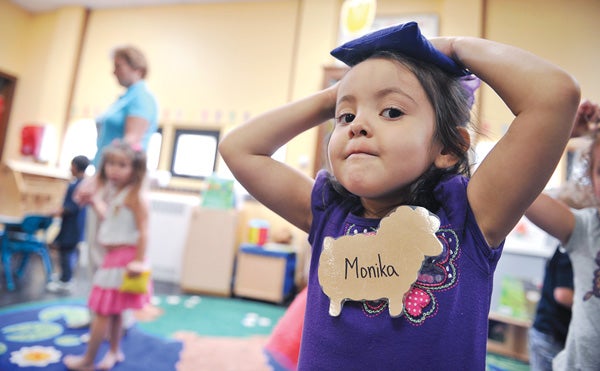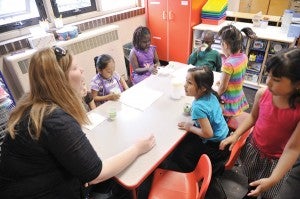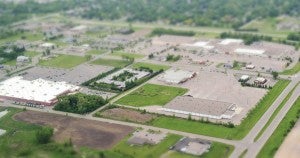Future begins now
Published 4:00 am Wednesday, May 23, 2012

Three-year-old Monika Gutierrez plays a game with a beanbag during the Early Childhood Family Education class Thursday at the Community Learning Center. - Eric Johnson/photodesk@austindailyherald.com
As the Vision 2020 project committee kicks off, there’s still many goals to define and accomplish. Committees are meeting regularly to hone their goals and map out plans to get there. Over the past several weeks the Daily Herald has featured the Vision 2020 projects that will shape Austin for the next eight years. This is the third and final look at the ideas Austin residents hope to accomplish by 2020.

Preschool teacher Amy Goette asks her students what they are going to do after school during a snack break Thursday morning at the Community Learning Center. - Eric Johnson/photodesk@austindailyherald.com
Leading education
It’s no secret education is important in Austin.
From the Community Learning Center all the way through Riverland Community College, Austinites have plenty of schooling options. Yet the Vision 2020 “education leaders” committee is dedicated to making Austin’s schools a leader throughout the state, though committee members are still figuring out what that will mean.
“As the world continues to change, we understand that education needs to change with it,” said Randy Kramer, chairman of the education committee and Ameriprise financial advisor.
As many of the initial ideas dealt with education, few were surprised it made the top 10.
“The community really believes that education is a priority to having a successful and dynamic town,” said Austin Superintendent David Krenz.
Yet the committee’s mission — in effect to create a strong network between existing education outlets for the community — is fairly broad, so there’s plenty of room for interpretation.
That’s why committee members are evaluating what resources each school district has — from Pacelli Catholic Schools and Austin Public Schools to Riverland. Though the committee is mostly composed of local educators, committee members say they hope to get more volunteers to help decide what it wants to accomplish and how each school’s assets can help.
“We have to get some definite goals set up,” said Greg Larson, Austin Public School board member and education committee member.
The education committee will meet next at 6 p.m. June 12. While members originally planned to meet at the Town Center, the meeting could be switched to another location depending on how many volunteers attend.
“We need to get input from a lot of sources throughout the community to make good decisions on the current state of education,” Kramer said.
Community pride
Vision 2020’s “community pride and spirit” committee faces a couple challenges that other committees may not have.
First, it has to define what community pride and spirit actually means. Second, it has to define some measure of what success is. But the committee members have time, and they have only met once.
While the committee must have a chair by June, it may take until fall or later for concrete ideas to form, said Austin Area Chamber of Commerce executive director and Vision 2020 steering committee member Sandy Forstner.
“It’s not something that’s going to happen overnight,” he said.
He added that people will join and leave committees throughout the eight years, so projects and ideas will evolve, as well.
“The doors are always open to all these committees,” Forstner said. “If a person hasn’t been to a committee meeting yet, they can still join, and they will be able to join on an ongoing basis for a very long time.”
Committee members tossed around a few vague ideas at their first meeting on May 3, such as small-scale neighborhood fixer-uppers, expanding existing programs like Habitat for Humanity and Spruce Up Austin. Most have indicated that any real initiatives are unclear at this point.
One committee member, Aaron DeVries, joined because he hopes to implement more opportunities for his daughter and other parents who have children with special needs.
“We have a daughter who has special needs, and I feel there is a need for mentors for special needs in the community,” he said.
But community pride members realize their Vision 2020 committee has to focus on many sectors of the community, too.
“We’re hoping that they have multiple projects and goals,” Forstner said. “Some short-term that are easily achieved and some long-term — some real difference makers.”
DeVries agrees with that statement, and added that community pride means including all ethnicities, ages and abilities, as well.
Still, he knows measuring success may be subjective. He said simply an increase in people helping across the board could indicate success.
“If more people participate in the project, making Austin a better town, I guess that would be success in my perspective,” DeVries said.
The community pride committee will meet again this Thursday with hopes of appointing a chairperson.

One of the top 10 Vision 2020 ideas was the further development of the 18th Avenue NW business district, including a major push to fill the former Cash Wise and K-mart buildings, lower right. - Eric Johnson/photodesk@austindailyherald.com
Becoming business friendly
Austin business leaders aim to make Austin truly distinctive.
That’s the goal as the “business friendly environment” project committee looks for the best ways to attract new businesses and entrepreneurs to Austin, according to John Garry, committee member and executive director of the Development Corporation of Austin.
Garry said the DCA will work closely with Vision 2020 and be one of four main entities to do so, including the Austin Area Chamber of Commerce, the Austin Main Street Project and the city of Austin through Community Development director Craig Hoium. While the group has only met once, they have a meeting May 31, where they will start to map out a timeline and how each entity fits in.
“At the next meeting, we’ll focus on how those groups, what their roles are and how they work together,” he said.
The group doesn’t have specifics yet, but committee co-chair Rick Jaacks, president and CEO of Community Bank in Austin, said the focus will be on how to make Austin stand out.
“A lot of communities offer the same things to attract new businesses, so finding a unique selling proposition is key,” he said.
One area where Austin stands out, Jaacks said, is its growth in population. The city’s total population rose 6 percent between 2000 and 2010, from 23,314 to 24,718, according to the 2010 U.S. Census, which is unique for outstate Minnesota.
“Hopefully what that means is that as the community grows, there will be a demand for additional labor,” Jaacks said.
Another factor in Austin’s favor, according to Chamber executive director Sandy Forstner, is its low unemployment rate.
While Austin historically has been insulated from economic downturns and recessions — with roughly 3,000 of the 13,638 labor force working at either the Hormel Foods Corp. Austin plant or Quality Pork Processors — the 2008 recession took its toll locally, even as Hormel’s profits increased during the past three years. Still, Austin’s unemployment has remained consistently below the state and national average. Austin’s non-seasonally adjusted unemployment rate was 5.7 percent in March, compared to 6.6 percent in Minnesota and 8.4 percent nationally, according to the Minnesota Department of Employment and Economic Development.
As the group moves forward, it will begin to analyze Austin’s strengths and weaknesses, creating an asset map of the community and developing a plan, according to the project’s other co-chair, Jim Heilman, a tax manager for CliftonLarsonAllen.
“It’s about defining what our committee is and the goals we’re going to have going forward,” he said.
A unique Main Street
The secret to making downtown Austin the destination point all relies on two efforts: getting people outside, and finding Austin’s niche.
The committee focused on making Austin into a premier small city center is a group of 30-40 people that met for the first time this past week. The committee comprises mostly business owners, which committee chair Kiersten Hall said is a good start for a project like Vision 2020.
“We’re visionaries,” she said. “We’re entrepreneurs. We like to do crazy things and see if it works.”
Keeping an old-fashioned, hometown feel to Austin is essential while the committee works to build it up. Hall said she thinks most people appreciate that sentiment, and it makes them want to stick around a city, which is key to the committee’s efforts to get people to come downtown. Establishing gathering places where people can see familiar faces will ensure they keep coming back.
“People need to come out of their homes,” she said. “They need to come down and commune with one another.” She pointed to a lack of activity in the evenings as one symptom.
The key is to bring in different ideas to attract more than just business people, and the committee’s short-term target is Thursday nights, from 3:30 to 6 p.m. The farmers market kicked off Thursday as one such event to bring people downtown, but Hall hopes to generate a lot of different events that could bring in all kinds of people.
“I get on this binge where I have oodles of ideas,” she said. For example, the committee could work to bring in musical acts or a classic car show.
“It worked well for Rochester,” Hall said, referring to Rochester’s “Thursdays on First and Third,” a weekly summer event that features food, arts and crafts, live entertainment and over 100 vendors. “If there’s a business plan that already works, then do it.”
The concept ties in well with the committee’s second focus of establishing a theme for Austin.
That requires research, Hall said. The committee for the Vision 2020 project is starting by approaching small towns that already have a niche or theme established and trying to figure out what they did to achieve it. While the Spam Museum is a good plug for the area, Austin also needs something that focuses specifically on downtown.
When people think of Lanesboro, it brings canoes, restaurants and a playhouse to mind, Hall said. Stillwater means boats, bars along the river and warehouse retail outlets. Austin has to cement a connotation like that in people’s minds.
There’s potential for the Vision project’s goals to correlate with the Austin Main Street project, a program started in 2006 to preserve downtown as a “healthy, vibrant, economically vital center of commerce and activity,” according to the project’s website. Austin Main Street Coordinator Sarah Douty is part of the Vision committee.
The committee is ready to get going on the project, Hall said.
“We appreciate the fact that we can start moving and shaking right away, and getting the community involved,” she said. “It should be quite exciting, actually.”





